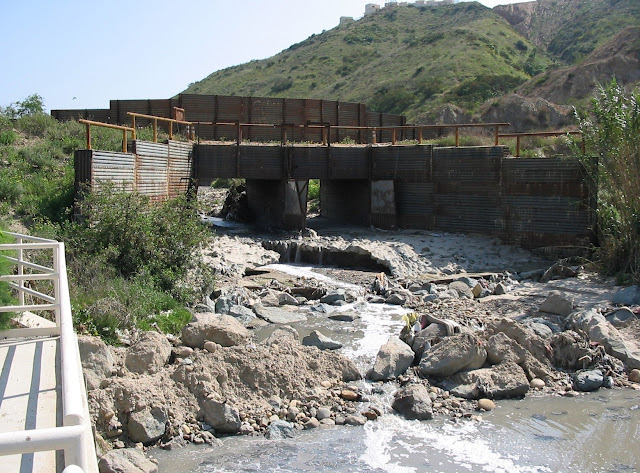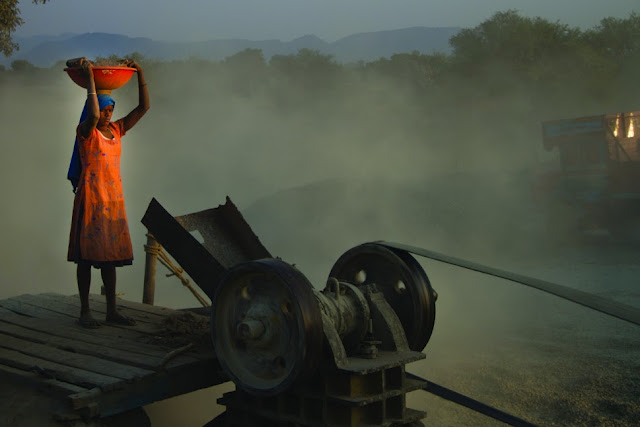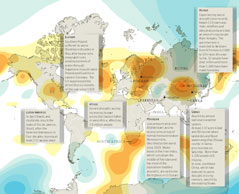-
Weather as a Weapon: The Troubling History of Geoengineering So Far
›September 27, 2010 // By Wilson Center StaffExcerpted from the original version of this article on Slate, by James Fleming.
Is there a technological fix for global warming? Where would we put a “planetary thermostat,” and who would control the settings? The long and tragicomic history of fixing the sky — of rainmakers, rain fakers, weather warriors, and climate engineers — indicates that such ideas are far-fetched. Dosing the stratosphere with sulfuric acid to turn the blue sky milky-white does not sound like a good idea. Neither does dumping an iron slurry into the oceans to fill them with algae and turn them soupy-green. A global forest of artificial trees? Storing massive amounts of carbon dioxide under our feet forever? A flotilla of ships pumping seawater into the clouds? Unlikely, unlikely, unlikely.
Global climate engineering is untested and untestable, and dangerous beyond belief. The famous mathematician and computer pioneer John von Neumann warned against it in 1955. Responding to U.S. fantasies about weaponizing the weather and Soviet proposals to modify the Arctic and rehydrate Siberia, he expressed concern over “rather fantastic effects” on a scale difficult to imagine and impossible to predict. Tinkering with the Earth’s heat budget or the atmosphere’s general circulation, he claimed, “will merge each nation’s affairs with those of every other more thoroughly than the threat of a nuclear or any other war may already have done.” In his opinion, attempts at weather and climate control could disrupt natural and social relations and produce forms of warfare as yet unimagined. It could alter the entire globe and shatter the existing political order.
Continue reading on Slate.
James Fleming is an environmental historian and Professor of Science, Technology, and Society at Colby College. ECSP and the Wilson Center will be hosting the launch of his new book, Fixing the Sky: The Checkered History of Weather and Climate Control, on October 6, 2010.
Photo Credit: Adapted from “Lever du jour,” courtesy of flickr user Solea20. -
The Effects of Climate Change on Water in South Africa and Tibet
›From Hydrology and Earth System Sciences Discussions, “Uncertainty in Water Resources Availability in the Okavango River Basin as a Result of Climate Change,” by D.A. Hughes, D.G. Kingston, and M.C. Todd, explores the effects of a two degrees Celsius global warming scenario on the Okavango River Basin, a “major natural resource for human water supply” shared by Angola, Botswana, and Namibia. The authors conclude that “there is a relatively high probability of large changes to the extent and duration of inundation within the delta wetland system during the 21st century,” and recommend multi-annual to decadal ecological assessments of assumed low rainfall and river flow to guide integrated river basin water management plans.
“Climate Change and Environmental Degradation in Tibet: Implications for Environmental Security in South Asia,” by P.K. Gautam in Strategic Analysis, argues for Tibet’s designation as a regional – if not global – common, for the sake of South Asian security. Tibet faces significant risk of ecological degradation due to climate change. Further degradation of its water supply would significantly affect India, China, and Southeast Asia. According to Gautam, establishing Tibetan autonomy would ensure greater ecological preservation, contrary to the rapid development model pursued by China. -
Women, Water and Conflict as Development Priorities Plus Some Geoengineering Context
›September 24, 2010 // By Geoffrey D. DabelkoHere are some useful links to environment, population, and security work that recently crossed my desk.
• NYU’s Richard Gowan dissects UK development minister Andrew Mitchell’s encouraging speech identifying conflict-affected states as special DFID priorities. Gowan pulls out highlights from the speech and parses NGO reaction to it on Global Dashboard.
• Council on Foreign Relations’ Isobel Coleman provides five practical suggestions for tapping into women as the “new global growth engine,” on Forbes.
• The Aspen Institute announced its Global Leaders Council for Reproductive Health this week. Their goal: meeting unmet demand for family planning services by 2015 on the MDG schedule. That is over 200,000,000 women who want services but do not have access.
• I’m heartened to see the U.S. Senate pass the Senator Paul Simon Water for the World Act. Hoping the House will follow suit. Last time Congress passed legislation on water, sanitation, and health priorities, the 2005 Senator Paul Simon Water for the Poor Act enjoyed overwhelming bipartisan support.
• Colby historian Jim Fleming, writing in Slate, puts the increasing fascination with geoengineering as a climate response “option” in some sobering historical context. “Weather as a Weapon: The Troubling History of Geoengineering” is the short read. Tune in to hear Jim present the book length version, Fixing the Sky, at the Wilson Center, October 6th at 10:30 am EST.
Follow Geoff Dabelko (@geoffdabelko) and The New Security Beat (@NewSecurityBeat) on Twitter for more population, health, environment, and security updates. -
Environmental Security Along the U.S.-Mexico Border
›
In 2005, the U.S. Department of Homeland Security (DHS) began the construction of a massive earthen, concrete, and metal security barrier along much of the U.S.-Mexico border, from the Pacific Ocean to the Gulf of Mexico.
Framing it as an issue of national security, DHS used provisions in the Real ID Act to waive environmental laws and citizen review for the controversial infrastructure project.
Unfortunately in Imperial Beach, California – my corner of the U.S.-Mexico border – the poorly engineered barrier has caused serious environmental mishaps and damage. In 2009 the Voice of San Diego reported that DHS circumvented numerous local and state laws in the course the barrier’s construction:Were it anyone else’s project, state regulators would’ve required irrigation to ensure that plants grew. But the federal government is responsible for the $59 million effort to complete and reinforce 3.5 miles of border fence separating San Diego and Tijuana. The Department of Homeland Security exempted itself from eight federal laws and any related state laws that would have regulated the project’s environmental impacts.
The Voice goes on to report that state water regulators also have no jurisdiction over the project since it has been exempted from the federal Clean Water Act.
“They did better engineering in 8th century China,” said Joe Sharkey of The New York Times, whom I took on a tour of the border, about the massive amphitheater of dirt that DHS dumped in Smuggler’s Gulch a few miles from the Pacific.
Ironically, while DHS has focused its efforts on the massive earthen and concrete wall, the agency has virtually ignored the tidal wave of polluted sewage water and garbage that flows across this section of the U.S.-Mexico border, a problem that makes the very people charged with safeguarding our security – border patrol agents and even Navy Seals – often unable to carry out their mission.
Over the past 20 years, border patrol agents have become ill from contact with the region’s polluted rivers, as well as the Pacific Ocean. In the Calexico-Mexicali region, border patrol agents worked directly with the Calexico New River Committee to clean up the New River – a drainage canal turned toxic hot spot.
Navy Seals based in Coronado, California, about 10 miles north of the U.S.-Mexico border, train in an area of the ocean that is directly impacted by polluted water flowing across the border from Mexico, bypassing the vaunted concrete and metal border barrier.
The organization I run, WiLDCOAST, is now working with U.S. agencies such as the International Boundary and Water Commission and the Environmental Protection Agency along with agencies in Mexico (e.g., CONANGUA and the state of Baja California) to reduce the threats to our military personnel and federal employees as well as border residents from cross-boundary pollution.
This cooperation has required a significant investment on the part of both the Mexican and U.S. governments in developing real solutions to our environmental security crisis on the border. Unfortunately the massive Berlin Wall-style barrier on our southern border is of little assistance in this effort.
Solving complex transboundary issues sometimes requires ignoring the cacophony of politics from distant capitals and instead working on the ground with colleagues from both nations who are experts in their shared geography. It appears the Obama administration is now slowly trying to repair some of the damage done to local communities, the cross-boundary relationship with Mexico, and our fragile shared environment.
But much more work and investment is needed to safeguard those we entrust to protect our security along the borderlands, as well as the residents of the region, from pollution that ignores international divisions and concrete walls. We must remember not only the national security component of our border-strengthening efforts but also the effect on human and environmental security as well.
Serge Dedina is the executive director of WiLDCOAST. He grew up and still lives on the U.S.-Mexico border in Imperial Beach, California. He is the author of Saving the Gray Whale and the forthcoming Wild Sea: Eco-Wars and Surf Stories From the Coast of the Californias.
Sources: Defenders of Wildlife, Environmental Protection Agency, University of Arizona, Voice of San Diego, WiLDCOAST.
Photo Credit: Serge Dedina. -
Climate Science, Military and Gender Roles, and the Tibetan Plateau
›September 14, 2010 // By Geoffrey D. DabelkoHere are some useful links to environment, population, and security work that recently crossed my desk.
• Need a break from the raging debate set off by Halvard Buhaug’s Proceedings of the National Academy of Sciences quantitative-based critique of climate and African civil war linkages (or lack thereof)? Check out some of the correlations Cullen Hendrix and Idean Salehyan of University of North Texas find in their piece “After the Rain: Rainfall Variability, Hydro-Meteorological Disasters, and Social Conflict in Africa.”
• A German military think tank report worries about the economic and political implications of peak oil over a relatively short time frame.
• Militaries’ humanitarian responses to extreme weather events rather than actual shooting wars are the focus of “The Coming Conflicts of Climate Change,” by U.S. Navy Foreign Area Officer Michael Baker. Baker is writing for the Council on Foreign Relations as one of their International Affairs Fellows.
• Oxfam America and IUCN staff experts call for greater consideration of different gender roles in addressing climate change. UN climate institutions are targeted in the IPS story.
• Journalist Steve Solomon highlights the high politics of transboundary water in Asia with a piece in Forbes. China’s control of the Tibetan water tower with massive dam building amps up the pressure in South and Southeast Asia.
• Canadian scholar Eric Kaufmann’s book, Shall the Religious Inherit the Earth? breaks down relative population growth rates between the religious and the secular. One is high, one is below replacement level. So far the book is only published in Europe but you can get it from Amazon UK.
• The highly respected science journal Nature editorializes against the rising tide of loud anti-science demagoguery. Strong words on the U.S. political context.
Follow Geoff Dabelko (@geoffdabelko) and The New Security Beat (@NewSecurityBeat) on Twitter for more population, health, environment, and security updates. -
Climate-Security Linkages Lost in Translation
›A recent news story summarizing some interesting research by Halvard Buhaug carried the headline “Civil war in Africa has no link to climate change.” This is unfortunate because there’s nothing in Buhaug’s results, which were published in the Proceedings of the National Academy of Sciences, to support that conclusion.
In fact, the possibility that climate change might trigger conflict remains very real. Understanding why the headline writers got it wrong will help us better meet the growing demand for usable information about climate-conflict linkages.
First, the headline writer made a simple mistake by translating Buhaug’s modest model results — that under certain specifications climate variables were not statistically significant — into a much stronger causal conclusion: that climate is unrelated to conflict. A more responsible summary is that the historical relationship between climate and conflict depends on how the model is specified. But this is harder to squeeze into a headline — and much less likely to lure distracted online readers.
Buhaug tests 11 different models, but none of the 11 corresponds to what I would consider the emerging view on how climate shapes conflict. Using Miguel et al. (2004) as a reasonable representation of this view, and supported by other studies, there seems to be a strong likelihood that climatic shocks — due to their negative impacts on livelihoods — increase the likelihood that high-intensity civil wars will break out. None of Buhaug’s 11 models tested that view precisely.
If we are going to make progress as a community, we need to be specific about theoretically informed causal mechanisms. Our case studies and statistical tests should promote comparable results, around a discrete number of relevant mechanisms.
Second, a more profound confusion reflected in the headline concerns the term “climate change.” Buhaug’s research did not look at climate change at all, but rather historical climate variability. Variability of past climate is surely relevant to understanding the possible impacts of climate change, but there’s no way that, by itself, it can answer the question headline writers and policymakers want answered: Will climate change spark more conflict? For that we need to engage in a much richer combination of scenario analysis and model testing than we have done so far.
We are in a period in which climate change assessments have become highly politicized and climate politics are enormously contentious. The post-Copenhagen agenda for coming to grips with mitigation and adaptation remains primitive and unclear. Under these circumstances, we need to work extra hard to make sure that our research adds clarity and does not fan the flames of confusion. Buhaug’s paper is a good model in this regard, but the media coverage does not reflect its complexity. (Editor’s note: A few outlets – Nature, and TIME’s Ecocentric blog – did compare the clashing conclusions of Buhaug’s work and an earlier PNAS paper by Marshall Burke.)
The stakes are high. This isn’t a “normal” case of having trouble translating nuanced science into accessible news coverage. There is a gigantic disinformation machine with a well-funded cadre of “confusionistas” actively distorting and misrepresenting climate science. Scientists need to make it harder for them to succeed, not easier.
Here’s how I would characterize what we know and we are trying to learn:1) Economic deprivation almost certainly heightens the risk of internal war.
To understand how climate change might affect future conflict, we need to know much more. We need to understand how changing climate patterns interact with year-to-year variability to affect deprivation and shocks. We need to construct plausible socioeconomic scenarios of change to enable us to explore how the dynamics of climate, economics, demography, and politics will interact and unfold to shape conflict risk.
2) Economic shocks, as a form of deprivation, almost certainly heighten the risk of internal war.
3) Sharp declines in rainfall, compared to average, almost certainly generate economic shocks and deprivation.
4) Therefore, we are almost certain that sharp declines in rainfall raise the risk of internal war.
The same scenarios that generate future climate change also typically assume high levels of economic growth in Africa and other developing regions. If development is consistent with these projections, the risk of conflict will lessen over time as economies develop and democratic institutions spread.
To say something credible about climate change and conflict, we need to be able to articulate future pathways of economics and politics, because we know these will have a major impact on conflict in addition to climate change. Since we currently lack this ability, we must build it.Marc Levy is deputy director of the Center for International Earth Science Information Network (CIESIN), a research and data center of the Earth Institute of Columbia University.
Photo Credit: “KE139S11 World Bank” courtesy of flickr user World Bank Photo Collection.
-
Fire in the Hole: A Look Inside India’s Hidden Resource War
›August 18, 2010 // By Schuyler Null -
Floods, Fire, Landslides, and Drought: The Guardian’s “Weather Crisis 2010”
› From the Guardian’s DataBlog comes an excellent overview of some of the extreme weather affecting the globe this summer, from the devastating floods in Pakistan which have inflicted “huge losses” to crops and exacerbated an already tenuous security situation, to the wildfires in Russia which have smothered the capital in dangerous smog and crippled domestic wheat supplies.
From the Guardian’s DataBlog comes an excellent overview of some of the extreme weather affecting the globe this summer, from the devastating floods in Pakistan which have inflicted “huge losses” to crops and exacerbated an already tenuous security situation, to the wildfires in Russia which have smothered the capital in dangerous smog and crippled domestic wheat supplies.
“Global temperatures in the first half of the year were the hottest since records began more than a century ago,” writes author and graphic artist Mark McCormick.
The orange areas of the map represent high pressure systems and the blue, low pressure systems, which as explained by Peter Stott of the Met Office, are important indicators of the rare climatic conditions that caused this summer’s abnormal conditions across Eurasia.
The flooding in Pakistan has garnered the most international attention, having now affected more people than the 2004 tsunami, 2010 Haiti earthquake, and 2005 Kashmir earthquake combined. Other highlighted areas of the map include flooding in Poland and Germany, drought in England, mudslides in Latin and South America, record-breaking drought and hunger in West Africa, and flooding and landslides in China, which recently pushed the world’s largest hydroelectric dam to its limit and have now been blamed for more than 1,000 deaths.
Although it does a good job highlighting the frequency and severity of extreme weather events this summer, it’s important to note that the map only covers events in July and August. That leaves out the “1000-year” floods in Tennessee this May as well as the heavy snowfall seen in the Northeast United States and the winter of “white death” in Mongolia earlier this year, which also severely disrupted local and national infrastructure as well as a great many people’s livelihoods.
Sources: Agence France-Presse, BBC, Guardian, National Oceanic and Atmospheric Administration, New York Times, Telegraph, UN Dispatch.
Image Credit: “Weather Crisis 2010” by Mark McCormick, courtesy of Scribd user smfrogers and The Guardian.
Showing posts from category environmental security.











